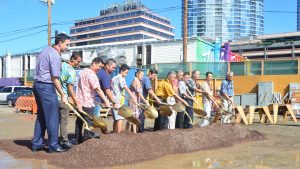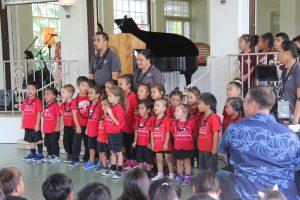From the governor: Working together on tough, vital issues
Posted on Feb 26, 2018 in Featured
Gov. Ige, developer Stanford Carr and others break ground for Hale Kewalo, an affordable rental project in Kaka’ako.
Whether it’s affordable housing or transportation improvements, the Ige administration has its eyes on the future even as it’s dealing with the issues of today. This issue of Capitol Connection describes some of the progress we’re making in tackling big issues such as affordable housing and protecting our islands and what Hawai‘i’s people can look forward to in the years ahead.
Q. Is there more the state can do to increase affordable housing?
A. Since I took office, we’ve focused on making policy changes and providing additional funding to make projects affordable. We’ve also made state land available where possible to reduce project costs. It’s always about finding the balance between providing more housing for local families and addressing concerns about the environment and agricultural land. We also want to encourage public-private partnerships to help with infrastructure because we have to have the sewer and water capacity before we can build.
Q. Why is housing along transit lines so promising?
A. First, the state-owned land near transit hubs can be our contribution to a public-private partnership. We also want to encourage “smart communities” by giving residents access to critical services without having to drive their cars. If we have affordable housing along transit routes, then we can really shape how communities develop, connect UH system campuses and encourage neighborhood businesses.

Punana Leo Hawaiian immersion preschool keiki sing at the Washington Place event to celebrate “The Year of the Hawaiian.”
Q. What makes “The Year of the Hawaiian” personally significant for you?
A. Thirty years ago, one of the first public school Hawaiian immersion programs was launched at Waiau Elementary in my House district. It was my first term in the Legislature, and it was Gov. John Waihe‘e’s first year in office. I understood that to save the culture we had to save the language and help children master it early. From the brink of extinction, the language is now thriving and spoken by more than 20,000 people. In honoring the accomplishments of our Native Hawaiian people, we can celebrate the values, culture and traditions they have shared with all of us and honor Queen Lili‘uokalani’s legacy.
Q. What should we know about lessons learned from the false missile alert?
A. Brig. Gen. Kenneth Hara’s report provides a detailed road map to make sure our state is prepared to handle any hazard. Among the lessons learned by Hawai‘i’s Emergency Management Agency (HI-EMA) is that you need a comprehensive plan involving all community sectors and federal agencies. HI-EMA was trying to get ahead of the curve because of North Korea’s increased missile activity, but they were still in the first phase of planning. After the National Governors’ Association conference in Washington, D.C., I’ll have more to report on meetings with some of our federal partners so we can move forward. I’ll also be asking our state Legislature for more than $2 million to build our system capacity to ensure the safety and security of the people of Hawai‘i.